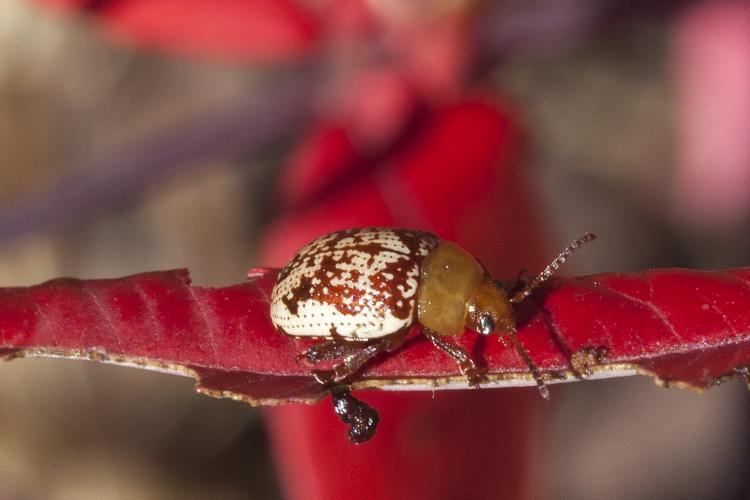Natural Selections
Sumac flea beetles make good use of a distasteful host plant
I first saw a photo of a sumac flea beetle posted by Steve Mlodinow in Flickr, a public platform to post photos and enjoy the works of others. I looked for the beetles, but had no luck until Steve told me exactly where to find them. I have now formed a search image and have learned to look first for evidence of herbivory—holes in the leaves and gooey clumps of feces.
Adult sumac flea beetles are small, only about 6 mm or ¼ inches long, but they are colorful and distinctive. The head and thorax are yellow with numerous dimples. The elytra or wing covers have a cream background with irregular burgundy blotches and rows of burgundy indentations.
Larval and adult sumac flea beetles consume sumac leaves to get both nutrition and chemical defenses
As their common name suggests, sumac flea beetles are specialists on sumacs and both adults and larvae feed on them. I first saw beetles on aromatic sumac, also called skunkbrush, Rhus aromatica, at Heil Ranch, where Steve Mlodinow had found them. Subsequently, I found them on smooth sumac, Rhus glabra, on Flagstaff Mountain near Gregory Canyon. Flea beetles have little competition from other herbivores because both sumac species synthesize a diversified arsenal of chemical defenses including phytol, vitamin E, several fatty acids and tannins.
At both Heil Ranch and Flagstaff Mountain the distribution of beetles was very spotty; this pattern reflects the biology of their host plants. Aromatic and smooth sumacs grow as clones, so a clump of stems is a clone sharing a common root system. Previously, biologists had written that the flea beetles might defoliate one clone but not feed on adjacent clones. Chemical comparisons of the chemical defenses showed that the beetles preferred clones with higher levels of defensive compounds, particularly phytol.
Adult sumac flea beetles do not have evident defenses. They are slow, they do not bite or sting and they have no sharp appendages. So how do they avoid being eaten by birds and chipmunks? After watching adults for a while, I learned that they were eating machines so that leaves were simultaneously being macerated at one end and expelled as a black, gooey mass from the other end. So I conclude that the beetles are packed from stem to stern with the chemicals that defend sumacs. This is their sole defense, and consequently, they prefer to feed on and lay eggs on clones with higher concentrations of defensive compounds.
Larvae are greenish yellow, about ½ inches long, and even slower than the adults. For their defense they adorn themselves with a fecal shield. Their posterior ends are modified to a forked structure that anchors the fecal shield. A larva has a muscular, protrusible, dexterous anus that can be extended to drape excrement over the fork and onto the back.
One of the first natural history observations of sumac flea fecal shields was that predatory ants that contacted the fecal mass immediately retreated and groomed intensively, showing that they had encountered chemical deterrents. But if biologists removed the fecal shield from larvae, ants would kill them and take them back to their nest. If larvae were reared on a diet of lettuce their fecal shield did not deter ants at all. If the lettuce-laced shield was removed and replaced with a shield produced by a larva feeding on sumac, the shield served as an effective deterrent. So it is not the disgusting appearance, or the noxious fragrance of excrement, but the compounds consumed while eating sumac leaves that make the fecal mass an effective deterrent.
I confess to a childish obsession with fecal shields and fecal clubs—they are ingenious adaptations that appeal to my sense of humor. I have now encountered three local species that use fecal shields: a tortoise beetle (Physonata unipunctata) that feeds on monarda or wild bergamot, a shield beetle (Cassida rubiginosa) that feeds on thistles, and the sumac flea beetle. When I first encountered the fecal shield of the tortoise beetle, I thought it was probably unique. But in fact, 7,000 species of leaf beetles have fecal shields.


